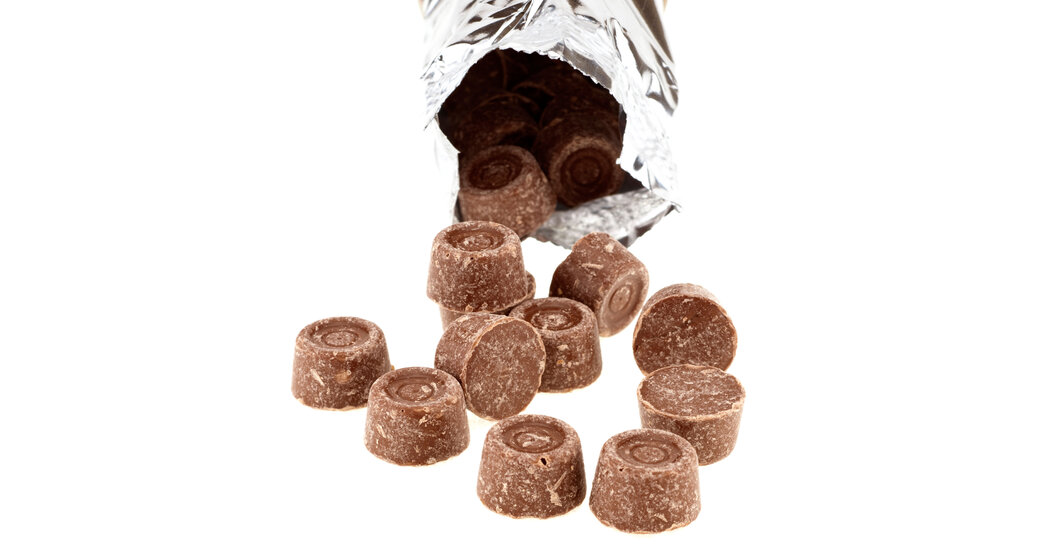Almost no one noticed when, sometime over the last few years, the packaging on Almond Joy, Mr. Goodbar and Rolo was updated to remove the words “milk chocolate.”
The edits were easy to miss: The description on the front of the Mr. Goodbar wrapper changed from “milk chocolate with peanuts” to “chocolate candy with peanuts.” Almond Joy is now marketed as a “coconut and almond chocolate candy bar.” Rolos are now wrapped in “rich chocolate candy” instead of “milk chocolate.”
I realized this earlier this year after eating a disappointing chocolate bar. It wasn’t spoiled, it just didn’t taste like I remembered. As a reporter who covers the climate, I’d read about global warming contributing to drought in West Africa and sending cocoa prices through the roof, and I knew candy companies had raised prices and shrunk portions.
But could it be that they were also tinkering with the makeup of the candy itself?
Yes, it turns out. Experts say high cocoa prices have triggered a wave of “reformulations,” the industry term for recipe changes. As the Halloween season boosts demand, some candy companies are replacing expensive cocoa butter with other fats, a swap that means their products no longer meet the U.S. regulatory definition of milk chocolate and can no longer be called that on packaging.
That’s why milk chocolate (a Food and Drug Administration-regulated term) has become chocolate candy. And these are just the most extreme examples. Armed with the latest confectionary techniques, candy scientists work hard to find reformulations that slip below the threshold for a mandatory label change. These might go undetected outside the industry and the tight-knit world of super-taster candy scientists.
Squint a little, and this is a success story: As shifting weather patterns make some ingredients more scarce, the food industry has deployed its multimillion-dollar research and development budget to adjust to major shifts in agriculture.
With little notice, evidence of the world’s changing climate has already sneaked into our sweets.
In recent years, longer droughts, extreme heat and irregular rainfall patterns have suppressed cocoa yields in West Africa, the crop’s primary growing region. An infection carried by mealybugs has also spread rapidly. Financial speculators, the threat of tariffs, labor issues and other geopolitical factors have compounded the problems.
In February, the nonprofit research group Climate Central published a study that found climate change had brought six additional weeks of extreme heat to most West African growing regions per year over the last decade, suppressing crop productivity.
The result of all the recent upheaval in the cocoa market is that prices have shot upward, reaching a peak of more than $10,000 per ton at the end of last year, roughly four times the price in 2022, according to the Federal Reserve Bank of St. Louis.
“When climate change bumps into structural problems and disease,” said Judy Ganes, a food industry consultant, “then prices go up and manufacturers are hesitant to pass through price increases and hurt their sales. Either consumers find something else or they try to reformulate.”
Food industry executives have openly acknowledged the trend of cutting down on cocoa ingredients to save money, but when it comes to answering questions about changes in their own recipes, they’re far more circumspect.
Asked about reformulations in a February earnings call, Steve Voskuil, Hershey’s chief financial officer said “it’s a place we look at, we test, and in some parts of our portfolio, over time we’ve made some changes,” and added that “there’s been no consumer impact whatsoever.”
The same month, Nestlé told investors it had saved more than $500 million through recipe reformulations as it shared a slide showing high cocoa and coffee prices. When I asked Nestlé for more detail, a spokesperson said candy made up a small portion of the cost savings and that much of it came from addressing “recipe complexity” and “harmonizing recipes” from different brands.
So how can you tell when your favorite candy changes? I compared current labels on the packages of Mr. Goodbar, Rolo caramels, and Almond Joy with past ingredient lists using the crowdsourced database Open Food Facts, a U.S. Department of Agriculture ingredient database, and data compiled by Richard Hartel, a food science professor at the University of Wisconsin-Madison who each year writes down ingredients in common chocolate bars for one of his classes.
(My process also involved a few trips to the grocery store, where I spent an inordinate amount of time squinting at the small print on Halloween candy variety packs.)
According to the databases, Rolo and Mr. Goodbar have changed since 2023, and Almond Joy seems to have changed sometime between 2020 and 2022. The Hershey Company, which makes all three candies, declined to comment. (Mr. Goodbar was also not technically milk chocolate for a handful of years starting in 2008, before it apparently switched back.)
But comparing labels can only tell enterprising candy lovers so much. Food scientists say they’re trained to tweak recipes in a manner that evades consumer detection.
Michelle Frame, founder of the candy development company Victus Ars, was the first person to develop flavored Peeps, an achievement that helped land her in the Candy Hall of Fame.
In the last year or so, Ms. Frame has noticed changes creeping into her life outside the laboratory. The milk chocolate coating on a Snickers bar she bought seemed thinner than it used to be. She stopped buying a favorite store-bought chocolate chip cookie after she noticed large chocolate chips had been replaced with a lower-quality substitute. (A Mars spokeswoman said Snickers coatings have not changed since 2019, when the candy’s coatings were reduced by a small amount.)
Ms. Frame said a common approach to reducing cocoa costs was to replace chocolate coating with compound coating, which is made with vegetable fats instead of cocoa butter. Some candy bars, like Butterfinger and Baby Ruth, have been made with compound coatings for years. Others, like Almond Joy, have changed more recently.
For candies without coatings, reformulation can be tricker. Candy makers have begun experimenting with realistic substitutes for cocoa butter. Dr. Hartel called this problem “a food scientist’s delight” because replicating cocoa butter’s precise texture and mouth feel is so complicated. It’s also a big business.
One of the most obvious substitution tells, he added, is the use of the word “chocolatey” on packaging.
Cargill, which sells ingredients to other companies, has noted an uptick in interest in chocolate alternatives, said John Satumba, the company’s director of global edible oil solutions research and development. Cargill has invested $35 million in a facility in the Netherlands that makes coatings and fillings using less cocoa, and is building a facility in Ohio to manufacture chocolate substitutes.
Globally, the company has invested $70 million in “cocoa butter equivalent capabilities.”
Another method is to replace chocolate with existing ingredients like sugar or chunky add-ins. Andrew Moriarty, senior cocoa analyst at Expana, a company that reports agricultural commodity prices, said this had resulted in the reversal of a long-term trend. Companies had been cutting back on added sugars over the last 10 years or so in response to consumer preferences, but sugar content has been quietly ticking upward more recently again as it replaces cocoa.
Elsewhere, a company might thin out a milk chocolate coating and slip a layer of chocolate compound beneath it. Cookie makers might shrink their chocolate chips, or use fewer, or mix in a combination of “real” and compound chocolate chips, Ms. Frame said.
Shoppers rarely notice these sleights of hand, but industry insiders tell a different story.
“We all know each other and we run around behind the scenes and we’re like, can you believe this stuff?” said Eric Schmoyer, technical innovations director at IRCA Group, a chocolate manufacturer.
Cocoa prices have come down some since their peak last winter, but analysts predict the supply crunch is here to stay as the planet warms. Demand for chocolate continues to increase, and expanding production takes time. Climate change is expected to stress crops with hotter days and shifting rainfall patterns, but new plantings may be limited by regulations prohibiting deforestation, Mr. Moriarty said.
In the long run, Dr. Hartel predicts, the chocolate market will split further in response to these pressures: High-end chocolate will most likely continue to be made with the same ingredients and people will continue to pay more and more for it. Companies will continue to look for ways to keep lower-quality chocolates affordable, whether it be through reformulations, shrinking packages or marketing new products that contain less cocoa.
This last strategy is evident this Halloween season. A Hershey’s Halloween assortment currently on the market includes light-green Kit Kats and Cookies ‘n’ Creme Fangs, neither of which contain any chocolate at all.
So what happened with the bad chocolate bar that sent me on this journey? I compared product labels and found no changes over five years. Still, plenty else could have been tweaked, the candy scientists told me: The company might have sourced beans from a different region, or compromised with lower-quality beans, or hired a different manufacturer.
Over the last several years, there have been no shortage of scary headlines about the ways the food system could transform as the world gets warmer, making some key crops less nutritious, trigging severe food shortages and widespread hunger. But there are also subtle shifts that have already landed on our plates, and masking them has become both possible and profitable.
The future may taste like my chocolate bar: A little worse in a hard-to-define way, whether it was made with different beans, less cocoa butter, or more sugar.
Then again, maybe it was just stale.
Mira Rojanasakul contributed reporting.
Claire Brown covers climate change for The Times and writes for the Climate Forward newsletter.
The post Why Did My Favorite Candy Bar Drop ‘Milk Chocolate’ From the Label? appeared first on New York Times.




